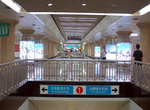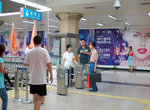Beijing, China
Overview
The Beijing Subway (Chinese: bei jing di tie) is a fast, economical, efficient and safe means of transportation in China’s sprawling capital city. Trains are fast and efficient (not to mention crowded all hours of the day), stations are clean, well-lit and easy to get around, and fares remain extremely inexpensive. Having opened in 1969 as a single line with 20 stations, the system has now grown to four lines and 67 stations. Many additional lines are currently either under construction or in planning stages.
The Lines
Line 1 is an east-west underground line running from Pingguoyuan station in the western suburbs to Sihui East. This line serves most of Beijing’s major points of interest, such as Tian’anmen Square, the Xidan, Dongdan and Wangfujing shopping districts, and the new Beijing Central Business District located at Guomao.
Line 2 (also known as the Loop Line) is a circular subway line serving important parts of the city’s central districts. The line connects to Line 1 at Fuxingmen and Jianguomen, and to Line 13 at Dongzhimen and Xizhimen. Most of Line 2 is located underneath Beijing’s Second Ring Road, which was originally the site of the former Beijing city wall.
Line 13 (also known as CityRail) is a so-called “light rail” line serving the suburban areas to the north of the city, with most of the line elevated or at ground level. The line parallels railroad rights-of-way for much of its length, except for the eastern section where it operates in the median of the Jingcheng Expressway.
The Batong Line (also known as Line 8T) is another light metro line similar to Line 13. This line connects the Bawangfen area at the eastern end of Line 1 to the urbanizing Tongzhou District in the eastern suburbs. The entire line is above ground, with much of it running in the center of the Jingtong Expressway.
The Future
Ambitious plans exist for the Beijing Subway’s future. Seven new lines are scheduled to be completed over the course of the next few years:
- Line 5, a north-south line serving important areas of the inner city and the suburbs. This line is scheduled to be opened in September 2007.
- Line 4, another north-south line serving the western half of the city center, as well as the new high-speed trains at Beijing South Railway Station.
- Line 8, a shuttle serving the new Olympic Park.
- Line 9, serving western and southwestern Beijing, as well as the Beijing West Railway Station.
- Line 10, following part of the Third Ring Road and serving the new Beijing Central Business District.
- Line L1, a non-stop light rail shuttle to the airport.
- Line L2, a light rail line serving the high-tech industrial area to the southeast.
Fares
Lines 1, 2 and 13 cost Ґ3 to ride, while the Batong Line costs Ґ2. However, free transfers may be made between lines 1 and 2 only; transferring to other lines requires payment of an extra fare. However, discounted transfer tickets exist: a ticket valid for a transfer between lines 1 or 2 and 13 is available for Ґ5, and the Batong Line has a similar transfer ticket for Ґ4.
Line 13 has an automated faregate system for fare collection, but the other lines continue to utilize traditional ticket checkers at platform stairways to check for tickets. The platform entrances on these lines remain too narrow for faregate arrays to be set up. All lines, however, accept Beijing’s new Yikatong smartcard for fare payment, which can be bought and refilled at all stations.
Rolling Stock
Despite its relatively small size, the Beijing Subway operates an extremely diverse fleet of rolling stock. Each line has at least two different types of passenger cars operating.
The original cars for the Beijing Subway were the classic DK2 and DK3 trainsets, built by the Changchun Car Company in the northeastern Chinese city of Changchun. “DK” stands for “diandong keche”, meaning an electrically-operated passenger car. These cars, known as “bread” by local railfans due to their rounded front windows, have all been retired; they spent their last days operating on Lines 13 and Batong prior to the arrival of modern rolling stock. Several inactive, rusting DK2 and DK3 trainsets can still be seen from Line 1 or Batong Line trains passing by the Sihui depot, and one DK2 has been preserved at Line 2’s Taipinghu depot as a training car. The DK2 and DK3 cars were also ordered by the North Korean capital of Pyongyang for that city’s subway, under the designation “DK4”, but that is for another article.
Following the DK2/3 cars were the DK6 and DK9, built in the early 1980s. Only one six-car trainset existed of this type (the front and end pairs were DK6s and the two middle cars were DK9s), which ran on Line 2 prior to retirement. These cars featured squared-off slanted front ends (curiously reminiscent of the New York City Subway’s R40 cars), but the rest of the car remained almost identical to the DK2/3.
The subsequent DK11 (ordered from 1984-1986) and DK16 (1986-1989) car groups were based on the DK6/9. Today the six-car DK11 and DK16 trainsets make up a significant percentage of the fleet on lines 1 and 2, respectively, although replacement is not far away. These cars have gone through a number of different liveries; the current one features a white base with a red stripe (Line 1 DK11) or a silver base with a blue stripe (Line 2 DK16.) Some DK16s on Line 2 have been refurbished, and these trainsets are distinguished by their updated interiors, LED screens, and new-style windows.
The BD1 (Line 2) and BD2 (Line 1) cars arrived from the Beijing Subway Rolling Stock Plant in the early 1990s. “BD” in these designations refers to “beijing ditie”, or “Beijing Subway.” The ends of these cars are similar to the earlier DK11 and DK16s, but they feature sloping car sides and four doors per car (three on the previous stock.) These cars were the first to feature AC propulsion. All of these cars have been repainted with the new silver paint scheme.
The DK20s, similar to the BD1s and BD2s, were ordered from the Changchun Car Company in 1994 and currently operate on Line 1. These cars, recently repainted in red and silver, are distinguished from the BD2s on Line 1 by their smoother edges and different end window configurations. Several of these cars have been refurbished with a restyled interior, LED information screens, and new windows.
Classes DKZ4 and BD11 (the latter is no longer operated) were ordered in 2000 from Changchun and the Beijing Subway Rolling Stock Plant. The “DKZ” designation stands for “diandong keche zu”; a group of electrically-operated passenger cars. The DKZ4s currently make up roughly half the current fleet for Line 1, while the two BD11 trainsets (originally intended for Line 2) sit idle at the Taipinghu depot. These cars are instantly recognizable by the large single window on their bulkheads; otherwise, they remain similar to the BD1/2 and DK20 class cars. The DKZ4s, originally featuring a white paint scheme with red and black stripes, are being repainted in silver and red.
When Line 13 was opened in 2002, it borrowed cars from the other lines until the new DKZ5s were ordered. DK2/3s, DK11/16s, and even obsolete subway cars from the cities of Pyongyang and Tianjin could be found. However, the DKZ5s were quickly ordered and are now largely the only rolling stock class found on Line 13. Based on the DKZ4 class, the four-car DKZ5 trainsets feature updated exterior styling with rounded corners and a smoother look, and a bright interior with LED information screens. The exterior paint scheme features a silver base with an orange stripe and blue front. These cars are nicknamed “the cats” for the headlights’ cat eye-like appearance. There is one trainset of DKZ6 cars (#H402) operating on Line 13, which is essentially a restyled DKZ5 with a stainless steel body. Line 13 is also home to #H457, a stainless-steel fully-articulated demonstrator trainset whose details are currently unknown.
Similar to Line 13, the Batong Line opened with outdated, obsolete cars initially serving the line. These, however, were all replaced with the four-car SFX01 and SFX02 trainsets by summer 2005. These trainsets, the newest for the Beijing Subway, are essentially updated DKZ5 trainsets with full articulation (meaning that one can walk from one end to the other) and a radically redesigned front bulkhead, which has earned these car classes the “red snake” nickname. The SFX02 cars are made of stainless steel, while the SFX01 cars were constructed with a traditional aluminum body; otherwise the two classes are identical.
Route Map

Photo Gallery
| Five Random Images | ||||
 Image 70346 (98k, 920x618) Photo by: Robert McConnell Location: Gulou dajie 鼓楼大街 (The Great Drum Tower Street) |  Image 70349 (196k, 920x618) Photo by: Robert McConnell Location: Guomao 国贸 (International Trade Centre) |  Image 70405 (177k, 920x618) Photo by: Robert McConnell Location: Tian'anmen East 天安门东 |  Image 70414 (178k, 920x618) Photo by: Robert McConnell Location: Wangfujing 王府井 |  Image 70416 (165k, 920x618) Photo by: Robert McConnell Location: Wangfujing 王府井 |
Page Credits
By Robert McConnell.